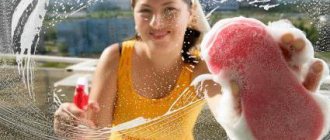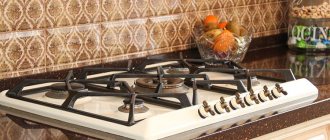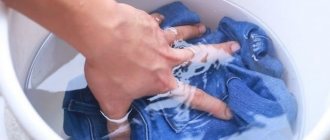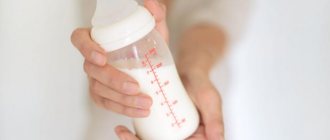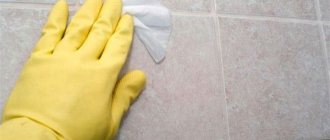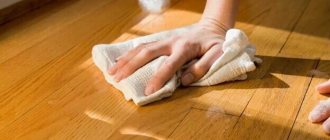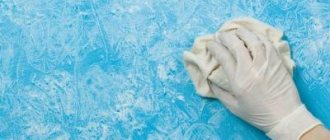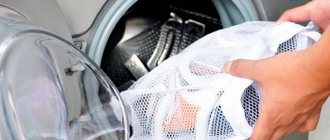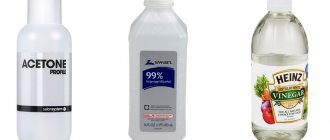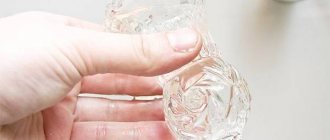During repair work, careless handling of tools and materials leaves a lot of contamination from construction mixtures, paints, sealants, and glue. If you don’t protect your floors, you’ll probably have to decide how to remove the primer from the tiles and the paint from the wallpaper. This can ruin all the joy from the updated interior. To protect yourself from unnecessary expenses, you need to take a responsible approach to the choice of covering materials and devices for open surfaces. It is enough to protect the floor and walls in time with thick paper, cardboard or plastic film, so that later you don’t have to guess how to wash the dried primer from the tiles. Old boxes from household appliances, bags from bulk products and putty will do for this. It is important to pay special attention to cleanliness when painting with primers, since their task is to prepare the surface for applying finishing paint or wallpaper glue, increase their adhesion, and increase the hardness of the top layer of the wall.
How to properly remove paint from a tiled floor?
The easiest way to clean tiled floors. The glaze, which makes up the protective film of the tile, is not susceptible to the penetrating properties of acrylic primers and is easily washed off with plain water and a dish sponge. It is more difficult with alkyd and polyester paints. They contain organic solvents that damage the glaze and spoil its appearance. It's even more difficult with ceramic tiles. It has pores that are easily filled with paint and are very difficult to part with. In this case, you can no longer do without cleaning products.
How to remove primer from ceramic tile floor tiles? First of all, you need to find out about this from the information on the paint packaging. The manufacturer will tell you how to remove the primer from the tiles. You need to start cleaning the floor immediately, as dried paint is much more difficult to remove. It is better to use cotton rags, which absorb any liquid very well, regardless of their chemical composition. An ordinary batting cloth, sold in hardware stores, is suitable for this.
How to clean?
Unfortunately, there is no universal way to clean a surface from primer. Any surface is made of a certain material, so the choice of cleaning method and substances that help in removing such stains depends on its type. Materials of different purposes and origins can be contaminated: window glass, tiles, plastic window sills, linoleum, laminate.
In addition, cleaning methods also depend on the type of primer.
The method for cleaning windows and tiles will depend on the type of primer. The easiest way to remove stains from these surfaces is from wallpaper glue, which is used to pre-treat walls before final wallpapering.
We suggest you familiarize yourself with Oil treatment of laminate flooring
Fresh stains can be easily washed off with a regular rag soaked in water. For dried stains, pre-wetting is best. With longer exposure to water, the adhesive substance swells, and the stain can be easily wiped off with a damp foam sponge. Then wipe the treated area dry with a handy product: a towel, rag, napkin.
Acrylic primer can be removed from floor tiles and window glass with water, especially if the stain is fresh. For high-quality wetting of the composition, a spray bottle is used. But if the primer contains dyes, then it will not be possible to wipe off the stain with water - in this case, it is better to use white spirit.
One of the most difficult primers to remove from glass and tile surfaces is the adhesive compound. In order to remove it from the surface, you will have to use mechanical force.
The cleaning process must be carried out with the utmost care; the blade in relation to the soil formation should be at an angle of 40-45 degrees, so that it is convenient to pick up the edge of the composition and remove it without scratching the glass. After mechanical removal of contamination, the treated area is wiped with a cloth soaked in water and then wiped dry.
Solvents will help remove the composition from glass and tiles on the floor. Organic solvent 646 is most suitable for removing adhesive primer. The prepared rag is moistened with the solvent and applied to the composition.
For complete interaction of the two substances, it is necessary to wait from 30 to 60 minutes, and only after that begin to remove the resulting jelly-like film, using a blade for this process. After removing the composition, the area is treated first with soap and then with plain water.
To remove phenolic primer from porcelain tiles or glass, you can use xylene, solvent, or a composition made from one part white spirit and one part solvent. The solvent or mixture is applied to the formation and left there for some time - as a rule, only 3-5 minutes are enough to soften the stain.
Sometimes it is not possible to determine the type of soil material, and therefore other means must be used. Of the available tools, baking soda and vinegar are the most effective.
Baking soda is a suitable cleaning agent for glass and tiles because it can soften the composition of many types of primer. In addition, when removing stains, soda acts as a mechanical abrasive. Apply a small amount of soda to the moistened stain to form a paste. After some time, the moistened mixture is removed from the surface.
Undiluted vinegar works well on stains on glass surfaces and acid-resistant tiles. To completely remove contaminants, the treatment is repeated several times at intervals of 15 minutes, washing off the mixture with water after each application.
Household chemicals produced to remove various contaminants will help get rid of stains. The following compositions of chemical reagents are known: Dopomat, Veroclean, Corvette, Atlas Szop.
Among the compounds mentioned, Corvette Deep Penetrating Cleanser is especially notable for cleaning porcelain tiles. Porcelain tiles are often used to finish floors in high-traffic areas, so this coating requires effective cleaning agents both before use and throughout its service life. To remove the primer material, the product is diluted with water according to the instructions, the resulting solution is used to wash off the stains, and then thoroughly rinse with water.
We suggest you familiarize yourself with How to clean floors after renovation from white deposits
Primer stains from tiles can also be removed with a steam cleaner, but such a device is not suitable for all types of tiles, but only for those whose structure is porous. In addition, it cannot be used to clean window glass, as there is a possibility of damaging the integrity of the glass due to uneven heating of the surface. The cleaning process is quick: a jet of steam is directed at the dirt, previously moistened with a solvent, and then cleaned off with a brush.
From linoleum
In order to remove a primer stain from linoleum, you must follow several rules.
Firstly, when cleaning fresh and not completely dried stains from the surface of this material with water, you must remember its temperature - regardless of the type of linoleum, the aqueous solution must be warm. There is a high probability of swelling or cracking of the coating from hot water.
Secondly, in order to avoid damage to the linoleum, all products used should be tested in a small, hidden area. Both simple available products (white spirit, vinegar, nail polish) and professional cleaners (Silit, Sif) will help in removing stains from linoleum.
In order to erase stains from the primer from the plastic surface of the window sill without damage, it is better to use either soft rags or foam sponges, since cleaning such a surface with a hard brush can lead to scratches.
The best means to help get rid of stains are solvents, acetone, gasoline, foam cleaner and other special products.
Gasoline works well to remove latex primer residue. To remove a stain, rub the problem area with a damp cloth, and then wash the area with soap and water.
To remove a stain using a foam cleaner, apply it to the stain. After a few minutes, the remaining contamination is removed with a sponge, and the cleaned area is washed with water.
From laminate
Removing stains from laminate flooring is not easy, but it is possible if you take into account some nuances.
There are rules by adhering to which you can avoid damage to such an expensive coating:
- You should not use products with an abrasive composition and use a mechanical cleaning method, as scratches may appear on the surface due to coarse particles of the composition or increased friction;
- You cannot use certain types of solvents - their composition can be detrimental to the drawing;
- Long-term contact of water with the coating should not be allowed, as there is a possibility of moisture getting between the seams of the panels, which will invariably lead to swelling of the material.
To clean this surface, you can use dishwashing liquid, white spirit, nitro solvent 649 or 650 and nylon mesh. Dishwashing detergent is applied to the stain and the primer is gently scrubbed off using a sponge. For complete cleaning, wipe the dirty area with a damp cloth and wipe dry.
When using a solvent, first moisten the sponge, and only then rub off the stain, removing the residue with a damp cloth.
You will learn more about how to properly remove primer by watching the following video.
How to remove dried primer from tiles?
When hardened primer remains unremoved for an extended period of time, it is next to impossible to remove. Even if the paint has dried, it is necessary to get rid of it as soon as possible. First, try to remove the paint film using a scraper or spatula. The primer that has retained its elasticity will pull the entire mass with it. If it gives in, then very carefully, not allowing the total mass of paint to separate, remove the contamination. If the coating has become brittle, then chip off pieces of it without effort, trying not to damage the base.
After this, they decide how to clean the primer from the tiles. Once again, the most ordinary dish sponge turns out to be an indispensable tool. When choosing it, it is better to give preference to light-colored or colorless sponges, since low-quality specimens, under the influence of cleaning agents and friction, release the paint that is in their composition. Such a sponge will do more harm than good.
How to remove primer from tiles?
- Why is it difficult to remove primer from tiles?
- How to clean the primer?
- Prevention measures
How to remove primer from tiles? During the renovation process, it often happens that it accidentally gets on the tiles. At first, stains from the primer are not noticed, and they remain on the surface for a long time. Then, when a certain time passes, they try to wash them, but they cannot.
Options for cleaning tiles from chemicals: ammonia or acetic acid, baking soda, thick detergents.
Features of removing paint from wall tiles
When solving the problem of how to wash the primer from the tiles on the wall, you need to choose thick cleaning products, since dealing with drips can become a headache. Solvents reduce the viscosity of paints, and the resulting solution penetrates even more deeply into porous surfaces and tile joints. When working, it is necessary to hold the highly absorbent material slightly below the cleaning area. This technique will prevent the dissolved paint from flowing along the wall. To speed up the process when cleaning walls, you can use more active products, since working on vertical surfaces is more difficult.
How to remove primer from floor tiles
When carrying out construction and repair work, it is necessary to prime the surfaces being treated. In this way, in addition to leveling, better adhesion of the laid material is ensured. It happens that drops of soil fall on the tiled floor. If you don't wipe them off right away, they stick tightly to it, leaving stains that are difficult to remove. Upon completion of the work, measures must be taken to wash the primer from the tiles on the floor. Knowledge of the means and methods helps to do this without harm to the coating.
Removing primer stains from tiles and stone
Bright, contrasting stains from tinted primer are the most difficult types of stains. How to remove primer stains from tiles? In this case, you need to carry out a whole cycle of work. If the oil-based primer has had time to dry, then the first step is to clean it mechanically. Oil paints are elastic and difficult to remove from surfaces.
In addition, they have good adhesion to surfaces. Oil-based primer films are not resistant to heat, so it is better to warm up the area of contamination. Then, using purified kerosene or a solvent for oil paints, the stains are removed.
How to remove acrylic primer from tiles?
The easiest way to get rid of acrylic compounds. This is a water-soluble paint that can be easily removed with ordinary household dishwashing detergents or simple washing powder. These contaminants can be easily cleaned mechanically. Dried acrylic primer is brittle and inelastic. With the help of a scraper, it can be easily removed from both the walls and the floor. However, even this primer adheres firmly to ceramic floor tiles.
It is even more difficult if it is a deep penetration primer. The chemical reaction in it makes it resistant to almost all cleaning methods. It is necessary not to allow such a primer to dry. To do this, until the stain is completely washed off, you need to ensure constant humidity of the surface, pour boiling water over it and leave a damp cloth on it. But the most effective way to combat acrylic stains is steam.
List of products for quick stain removal
What do you need to quickly clean paint stains to prevent them from setting? It is important to quickly respond to their appearance. To do this you need to have the following list of funds:
- several types of absorbent materials, preferably of natural origin;
- scrapers made of strong plastic with a metal handle;
- metal scrapers with a strong handle;
- a set of organic solvents for different paints;
- a set of household cleaning products;
- several packs of baking soda;
- small container with concentrated acetic acid.
Sequence of actions when cleaning floor coverings
If the floor has had time to dry and the paint has penetrated deep into the coating, then it is important to choose the right way to wash the primer from the tiles first. You need to act in the following sequence:
- Using a cotton rag, you need to blot the stain and not allow it to harden;
- if after the first action a stain remains, then it is necessary to pour a suitable solvent on it and repeat this until it completely disappears;
- if the stain was not noticed in time and has hardened, then it is removed with a suitable scraper, being careful not to scratch the surface;
- soak the stain with a suitable solvent or boiling water;
- leave a cotton cloth soaked in solvent on the stain for several hours;
- Using a kitchen sponge, wipe away any remaining dirt, being careful not to increase its area.
Phenolic primer
To impregnate wood, phenol-based soil is used. If it gets on the surface of ceramic tiles or glass and more than 17 hours have passed, then solvents will have to be used. For disposal, xylene, solvent or a mixture of solvent and White Spirit (in equal proportions) is suitable.
Cleaning is carried out according to the following scheme.
- A solvent is applied to the contaminated area.
- After 2-5 minutes, wipe with an abrasive sponge.
- Repeat wetting with the solution and wipe with a sponge again.
- Wash the glass with water.
We suggest you familiarize yourself with an accelerated method of removing rust with a solution of citric acid
To wipe off fresh dirt, simply wipe it with a rag or damp sponge.
Extreme cleaning methods
If nothing helps and there are no other means left, then stronger solvents are used, such as:
- chlorine-containing substances;
- solvents containing ammonia;
- vinegar essence;
- concentrated acid solutions.
When using these tools, you first need to worry about personal safety. All these liquids pose considerable danger. When working with them, you must use gloves, a respirator, and work only in a well-ventilated area.
Concentrated chlorine bleach for bedding is good for removing oil stains and other organic residues. Ammonia solvents will also remove oil paints. They can be used after bleach if its effect was not enough. When working with ammonia, be sure to use respiratory protection, as you can very easily get burned.
Vinegar essence will help remove stubborn stains on ceramic tiles and tiles. It penetrates deeply and does not harm the tile material. After this treatment, you need to thoroughly wash all surfaces with a baking soda solution. Such a complex treatment is very effective, since soda, when combined with acetic acid, causes the release of gas, which can push particles of unbound pigment out of the pores.
The most extreme method is to treat contaminants using solutions of hydrochloric and sulfuric acid. Hydrochloric acid degreases surfaces well and releases pigments bound by fatty films. Sulfuric acid dissolves organic dyes and metal compounds. All extreme methods are best left to professionals.
